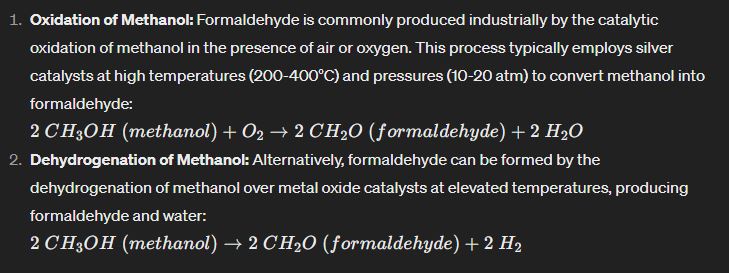Website can be closed on 12th to 14th Jan 2025 due to server maintainance work.
Assignment Title: Formation, Properties, and Identification of Formaldehyde and Acetaldehyde
Introduction:
Formaldehyde and acetaldehyde are important organic compounds with various industrial, commercial, and biological applications. In this assignment, we explore the formation mechanisms, properties, and methods for identifying these aldehydes, highlighting their significance in chemistry and everyday life.
Formation of Formaldehyde (CH2O)

Formation of Acetaldehyde (CH3CHO)

Identification of Formaldehyde and Acetaldehyde:
- Chemical Tests: Formaldehyde and acetaldehyde can be identified using various chemical tests based on their characteristic reactions. For example, both aldehydes react with 2,4-dinitrophenylhydrazine (2,4-DNPH) reagent to form orange or yellow precipitates, which can be confirmed by melting point determination or spectroscopic analysis.
- Chromatographic Techniques: Gas chromatography (GC) and high-performance liquid chromatography (HPLC) are commonly used analytical methods for the identification and quantification of formaldehyde and acetaldehyde in complex mixtures. These techniques rely on the separation of compounds based on their retention times and detection using suitable detectors such as flame ionization detectors (FID) or mass spectrometers (MS).
- Spectroscopic Methods: Fourier-transform infrared spectroscopy (FTIR) and nuclear magnetic resonance spectroscopy (NMR) are powerful techniques for the structural characterization of formaldehyde and acetaldehyde based on their unique spectral fingerprints. FTIR provides information about functional groups and molecular vibrations, while NMR offers insights into the chemical environment and connectivity of atoms in the molecule.
Conclusion:
In conclusion, formaldehyde and acetaldehyde are important aldehydes with diverse applications in industry, chemistry, and biology. Understanding their formation mechanisms, properties, and methods for identification is crucial for their synthesis, analysis, and utilization in various fields. By employing chemical, chromatographic, and spectroscopic techniques, scientists can accurately identify and quantify formaldehyde and acetaldehyde, enabling their safe and efficient use in a wide range of applications.
